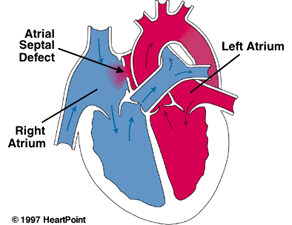
ATRIAL SEPTAL DEFECT (ASD)

This defect is characterized by incomplete closure between the two upper chambers of the heart. Blood can therefore flow through a hole (defect) in the wall (septum) between the upper chambers of the heart (atria) from one side to the other, causing some heart chambers to have to pump extra blood. The heart can dilate, the muscle can become weak, and the pressures in the pulmonary arteries can increase (pulmonary hypertension) due to the increase in blood flow. If the defect closes on its own or with the aid of surgery, these consequences can be avoided.
Blood flows mainly from the higher pressure left side to the right, although these is a little blood that crosses the other way. The defects may be of different sizes, and some may be associated with other abnormalities. Both of these factors determine whether and what type of surgery may be necessary.
If a substantial size defect is not corrected, then the pressures in the pulmonary arteries may become very high and induce changes in the arteries themselves such that even closure of the defect will no longer improve the patient. In this case, the pressures in the right side of the heart are high enough that blood may begin to flow from the right to the left side of the heart. This situation is called "Eisenmenger’s syndrome", a condition which may result from several similar abnormalites.
ęCOPY;1997 HeartPoint Updated November 1997
For more about Congenital Disease,
also see these related subjects on HeartPoint:
| Congenital Heart Disease |
Atrial Septal Defect | Coarctation of the Aorta | Ebstein's Anomaly | Patent
Ductus | Tetralogy of Fallot
|
| Transposition of the Great Vessels | Truncus Arteriosus | Ventricular
Septal Defect |
| Commentary |
Food You Will Love | HeartPoint
Gallery | In The News | Health Tips | What's New
| Information Center | Home
|
This site presents material for your information, education and entertainment. We can assume no liability for inaccuracies, errors, or omissions. Above all, material on this site should not take the place of the care you receive from a personal physician. It is simply designed to help in the understanding of the heart and heart disease, and not as a diagnostic or therapeutic aid. You should seek prompt medical care for any specific health issues. Please feel free to browse the site and download material for personal and non-commercial use. You may not however distribute, modify, transmit or reuse any of these materials for public or commercial use. You should assume that all contents of the site are copyrighted. ęCOPY;1997 HeartPoint